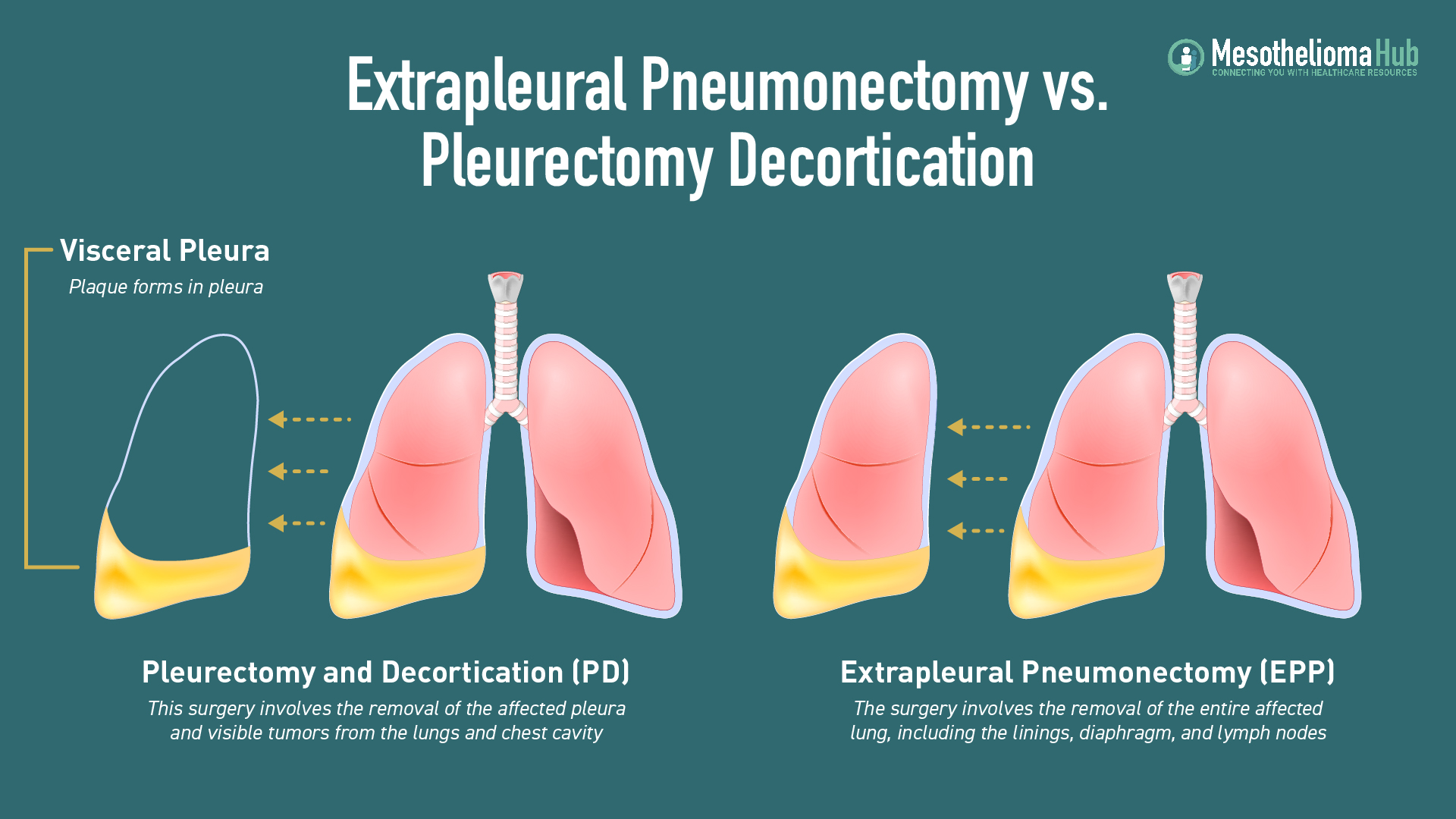Extrapleural Pneumonectomy (EPP) vs. Pleurectomy with Decortication (PD)
An extrapleural pneumonectomy (EPP) and a pleurectomy and decortication (P/D) are types of surgery for pleural mesothelioma treatment meant to relieve symptoms and extend the patient’s life. Both procedures remove tumors from the chest cavity and have higher success rates if cancer has not spread to other parts of the body.
Get Free Mesothelioma Guide
Types of Pleural Mesothelioma Treatment
Pleural mesothelioma and EPP treatment vary based on the cancer’s site, stage, and the patient’s overall health. Options include surgery, chemotherapy, radiation, immunotherapy, and targeted therapy. These treatments can be used individually or combined in multimodal therapy. Surgery, such as Extrapleural Pneumonectomy (EPP), aims to remove affected tissues, chemotherapy uses drugs to kill cancer cells, and radiation employs high-energy rays to target cancer. Immunotherapy boosts the immune system, while targeted therapy focuses on specific cancer cell genes or proteins.
Doctors choose treatments to either cure pleural mesothelioma or relieve symptoms, tailoring plans to each patient’s unique needs. EPP, in particular, is a surgical option for removing an entire lung and surrounding tissues. Understanding these treatment options helps patients and their families to make informed choices. Stay with us as we explore pleural mesothelioma and EPP treatment in detail, offering insights into their benefits and what you can expect.
Extrapleural Pneumonectomy (EPP) For Pleural Mesothelioma Treatment
An extrapleural pneumonectomy (EPP) is a surgical treatment for pleural mesothelioma that involves removing an entire lung and nearby tissues affected by cancer. This procedure is typically recommended for patients diagnosed with early-stage cancer that has not spread to surrounding tissues. Modern advancements have made pneumonectomies, including EPP, safer and more effective for treating pleural mesothelioma.
During an EPP, patients undergo general anesthesia. The surgeon makes a 10-inch incision at the front of the chest or on the side of the body to access and remove the affected lung and any visibly cancerous tissues. The surgery typically takes about three hours to complete.
EPP is a more invasive procedure with several risks, including a higher mortality rate of about 6% during or immediately after surgery. However, for eligible patients, EPP can significantly improve prognosis. Patients must understand the pre-surgery preparations, emotional considerations, and support available during recovery. Consulting with healthcare centers and professionals and preparing mentally and physically can help patients navigate this challenging but potentially life-extending procedure. Risks associated with an EPP include:
- Abnormal heart rate
- Blood clots
- Empyema (buildup of pus in the chest cavity)
- Infection
- Pneumonia
- Hemorrhage or internal bleeding
- Respiratory failure
- Death
Benefits of Extrapleural Pneumonectomy (EPP)
For patients with a less severe prognosis, undergoing an extrapleural pneumonectomy (EPP) can offer significant benefits. EPP can significantly decrease or eliminate the risk of mesothelioma spreading (metastasis) outside the lungs, potentially increasing the patient’s lifespan. Some patients may also experience improved symptoms, such as better breathing. To determine if a patient is eligible for EPP, several tests are conducted to ensure they are in good health:
- Blood tests – Detects decreased organ function or signs of infection.
- Echocardiogram (ECG) – Identifies abnormalities throughout the structure of the heart.
- Imaging studies – Provides images of the chest cavity and lungs.
- Pulmonary function tests – Assesses lung function.
While the potential benefits are significant, EPP is a major surgery with considerable risks, including a higher mortality rate. Therefore, a thorough evaluation of the patient’s overall health and detailed discussions with the healthcare team are crucial before proceeding. After the surgery, patients typically remain under the care of nurses and the surgeon for up to two weeks.
This hospital stay allows caregivers to monitor the patient’s health and support recovery through physical therapy, including breathing exercises and physical movements. Understanding both the potential benefits and risks of EPP can help patients and their families make informed decisions about their treatment options.
Seek Legal Compensation for Treatment
Evaluate My Case
Pleurectomy and Decortication (P/D) For Pleural Mesothelioma Treatment
A pleurectomy and decortication (P/D) is a surgical procedure used to treat pleural mesothelioma. Unlike an extrapleural pneumonectomy (EPP), a P/D does not remove an entire lung but rather the lining of the lung (the pleura and pleural thickening) and any visible tumors along the lung surface and chest cavity. This less invasive option is typically recommended for patients in good overall health and has a lower mortality rate compared to EPP.
During a P/D, the patient is placed under general anesthesia, and the surgeon makes an incision along the back or side of the chest cavity. The pleura and any other tissues affected by mesothelioma, including parts of the pericardium or diaphragm, are removed. Additional incisions may be made to access and remove all visible tumors. The procedure usually takes several hours to complete. During the hospital stay, patients receive care from nurses and the surgical team to monitor their health and aid in their recovery through physical therapy and breathing exercises. This support helps ensure that patients regain strength and functionality more quickly.
Patients undergoing P/D often experience improved symptoms and quality of life, with less recovery time compared to more invasive surgeries like EPP. Deciding between P/D and other treatments should involve thorough discussions with healthcare professionals to understand the risks, benefits, and expected outcomes based on the individual’s specific medical condition.
Deciding Between an Extrapleural Pneumonectomy and a Pleurectomy and Decortication
Choosing between an extrapleural pneumonectomy (EPP) and a pleurectomy and decortication (P/D) is a significant decision in pleural mesothelioma treatment. Patients must consider various factors, including the size and location of tumors, overall health, and treatment goals.
EPP involves removing an entire lung and surrounding tissues, aiming to eliminate cancerous cells more aggressively but with higher risks. On the other hand, P/D removes the pleura and visible tumors while preserving the lung, offering a less invasive option with potentially quicker recovery and fewer complications.
Patients should engage in detailed discussions with their healthcare team to make an informed decision. It is essential to understand the potential benefits and risks of each procedure, along with their personal preferences and goals. This process ensures that treatment aligns closely with the patient’s needs and maximizes the chances of a successful outcome.
If you or a loved one are facing this decision, consult your healthcare provider to explore which option may best suit your condition and circumstances. Your healthcare team is here to provide guidance and support throughout this journey. We can also help connect you to professionals as our advocates have fought for patient rights for decades. Contact us to find out how.
Mesothelioma Support Team
Mesothelioma Hub is dedicated to helping you find information, support, and advice. Reach out any time!

